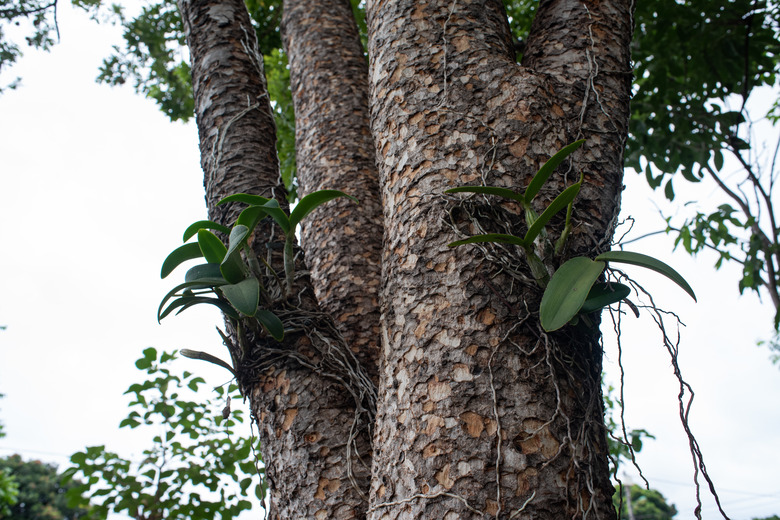Symbiotic Relationship Of The Orchid And Tree
Orchids are cultivated and prized by gardeners all over the world. According to experts, there are between 20,000 and 30,000 different species of orchids around the world. In the wild, orchids can be found on every continent except Antarctica, though the great majority of orchid species live in tropical and subtropical forests.
About three quarters of all orchid species are epiphytes. What are epiphytes? Epiphytes are plants that live and grow on other plants. Orchids growing on trees have a special kind of symbiotic relationship with their hosts.
Types of Symbiotic Relationships
Types of Symbiotic Relationships
Are orchids parasites? Symbiotic relationships between organisms can take different forms. Parasitism is a relationship where one organism, the parasite, receives or takes benefits at the expense of its host organism. Mutualism is a relationship where both organisms receive a benefit from the relationship.
Commensalism is a symbiotic relationship where one organism receives benefits, but the other is nether helped nor harmed. Most epiphytic orchids fall into this last category, where the orchid benefits but the host tree is not affected.
Features of Epiphytic Orchids
Features of Epiphytic Orchids
Like other plants, epiphytic orchids have leaves, stems, flowers and roots. Because they are anchored to host trees instead of soil, their root systems tend to be less extensive than plants that live on the ground but are capable of fast, efficient uptake of water and nutrients. Some have specialized leaf structures called trichomes to absorb nutrients from the air.
Orchids growing on trees are also capable of storing water in their stems to compensate for dry periods. They tend to grow on parts of trees that collect organic debris and water, such as on inner branches. Trees with rough bark that hold water and humus in cracks and crevices tend to support orchids better than those with smooth bark.
Many wild orchids on trees grow high in the branches, just below the tree canopy, where they can collect more sunlight. This position also allows epiphytic orchids to collect rainwater when it falls. Growing among tree branches reduces competition for scarce resources, a condition that plants on the dense forest floor often experience. Being up in the air also helps pollinators like insects and birds find epiphytic orchids.
Epiphytic Orchid Nutrition
Epiphytic Orchid Nutrition
Epiphytes need nutrients in order to survive, grow and reproduce. They acquire their nutrition in different ways. Some are capable of taking in everything they need directly from the air around them. Others glean water, minerals and nitrogen from the decaying organic matter of their host tree.
In another type of symbiotic relationship, some epiphytic orchid species rely on other organisms growing on the tree (such as fungi) for nutritional benefits. Other sources of nutrition include waste products from insects, birds and the decomposing organic material from other plants.
Negative Effects of Epiphytes
Negative Effects of Epiphytes
Although the epiphyte doesn't harm the host tree by taking away its nutrition, there are ways that the host tree can be affected. The sheer mass of excessive epiphytic growth can cause branch breakage. Some host trees with rough bark may shed pieces of their bark periodically, in order to prevent the overgrowth of orchids and other epiphytic plants. Other types of trees produce chemicals that can inhibit or discourage epiphyte growth.
Epiphytic Orchid Benefits
Epiphytic Orchid Benefits
Epiphytes increase the amount of moisture in the air, helping to keep the tropical rainforests humid. This is important in that it helps the rainforest trees absorb nitrogen from the air. The uptake and utilization of nitrogen through the nitrogen cycle is essential to plant growth, function and reproduction.
Like all species, epiphytic orchids play an important role in the ecosystems they are part of. Many have unique relationships with pollinators, and, like all plants, orchids absorb carbon dioxide from the air and release oxygen which then benefits humans and other animals.
Cite This Article
MLA
Guastella, Rose. "Symbiotic Relationship Of The Orchid And Tree" sciencing.com, https://www.sciencing.com/symbiotic-relationship-of-the-orchid-and-tree-12328242/. 30 September 2021.
APA
Guastella, Rose. (2021, September 30). Symbiotic Relationship Of The Orchid And Tree. sciencing.com. Retrieved from https://www.sciencing.com/symbiotic-relationship-of-the-orchid-and-tree-12328242/
Chicago
Guastella, Rose. Symbiotic Relationship Of The Orchid And Tree last modified March 24, 2022. https://www.sciencing.com/symbiotic-relationship-of-the-orchid-and-tree-12328242/
